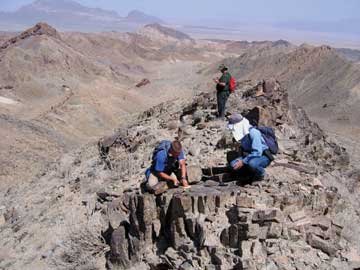|
NEWS NOTES
Geophysics
Understanding the crust beneath Iran
 Courtesy of Charles Verdel |
| Charles Verdel (left), Brian Wernicke (middle) and Ahmad Reza Malekpour (right) examined rocks in the Saghand area in Iran to determine when and how these anomalous rocks formed. |
The most recent continent-continent collision on Earth began about 10 to 20 million years ago when the Arabian Plate slammed into Eurasia in what is modern-day Iran. Because the crash happened so recently, many of the tectonic events that took place prior to it are not yet fully hidden, giving geologists a unique opportunity to study the region’s tectonic past. Now an international team of researchers has brought to light an important piece of this ancient history, which may explain some of the region’s volcanic and seismic activity.
Through examining surface geology and using radiometric dating methods, Charles Verdel of Caltech in Pasadena, Calif., and his team found evidence of geological structures called metamorphic core complexes that formed about 40 to 45 million years ago between the towns of Saghand and Posht-e-Badam in central Iran. The features hint at large-scale crustal extension, or thinning, in the region at that time.
Crustal extension causes faulting that allows rocks from mid- to lower-crustal depth — between 15 and 30 kilometers deep — to eventually become exposed at the surface, Verdel explains. Because the pressure and temperature at such depths are higher than at the surface, these rocks behave differently than those near the surface. “Deep rocks have more plasticity; they stretch like taffies or chocolate bars, while rocks at the surface are very brittle,” says Gary Axen of the New Mexico Institute of Mining and Technology in Socorro, who was not involved in this study. As a result, crustal extension causes deep rocks to deform, or metamorphose, and exhibit a fabric with minerals aligned in a preferential direction. Such mineral fabrics don’t form in rocks near the surface, Axen says. Patches of deformed and patches of brittle rocks form characteristic sequences called metamorphic core complexes.
Verdel and his colleagues became interested in studying the region when previous work by Jahandar Ramezani of MIT in Cambridge, Mass., unearthed highly metamorphosed rocks in the region. When Verdel and his colleagues examined the geology, they discovered that these rocks constituted the lower portion of a metamorphic core complex.
The formation of these structures between 40 to 45 million years ago could explain a pulse of volcanism that rippled across Iran at that time, Verdel says. “Thinning of the crust makes it easier for the mantle to undergo partial melting, and that can lead to volcanism,” he explains. Axen agrees that the crustal extension could have contributed to the sudden surge in volcanism, but notes that the volcanic activity was at least partially the result of subduction, created by the many collisions of continental fragments in the area during the past 100 million years.
Verdel and his team, who reported their findings in the July/August GSA Bulletin, say that a process called back-arc extension could have caused the crustal extension in the first place. “A crust that is subducting can peel back in the direction opposite to the direction it is subducting in and when that happens it can generate extension in the overriding plate,” Verdel says.
Metamorphic core complexes similar to those that Verdel and his team found in Iran occur all along the mountain chain that stretches from the Alps in the west to the Himalayas in the east (see Geotimes, July 2007). They are also a common feature throughout the western United States, Axen says. But, he adds, “Iran is just a gem of a place to study things like this because, even though the background work has largely been done, the country has had a lack of modern scientific work there because of its political situation.”
Links:
"Riding the Wilson Cycle," Geotimes, July 2007

 Subscribe
Subscribe


